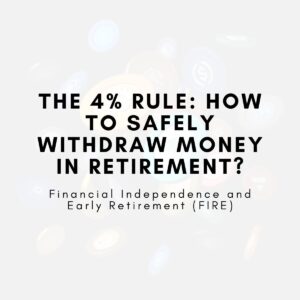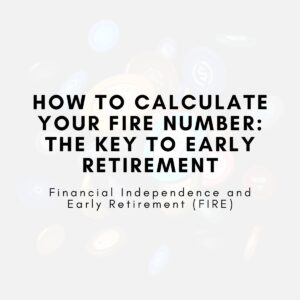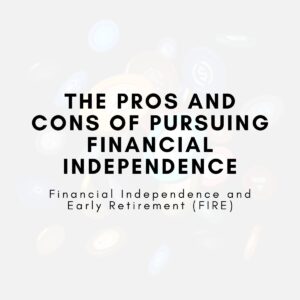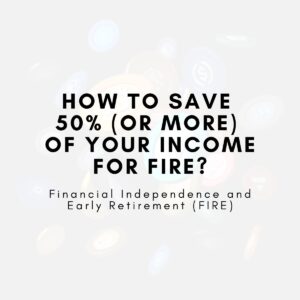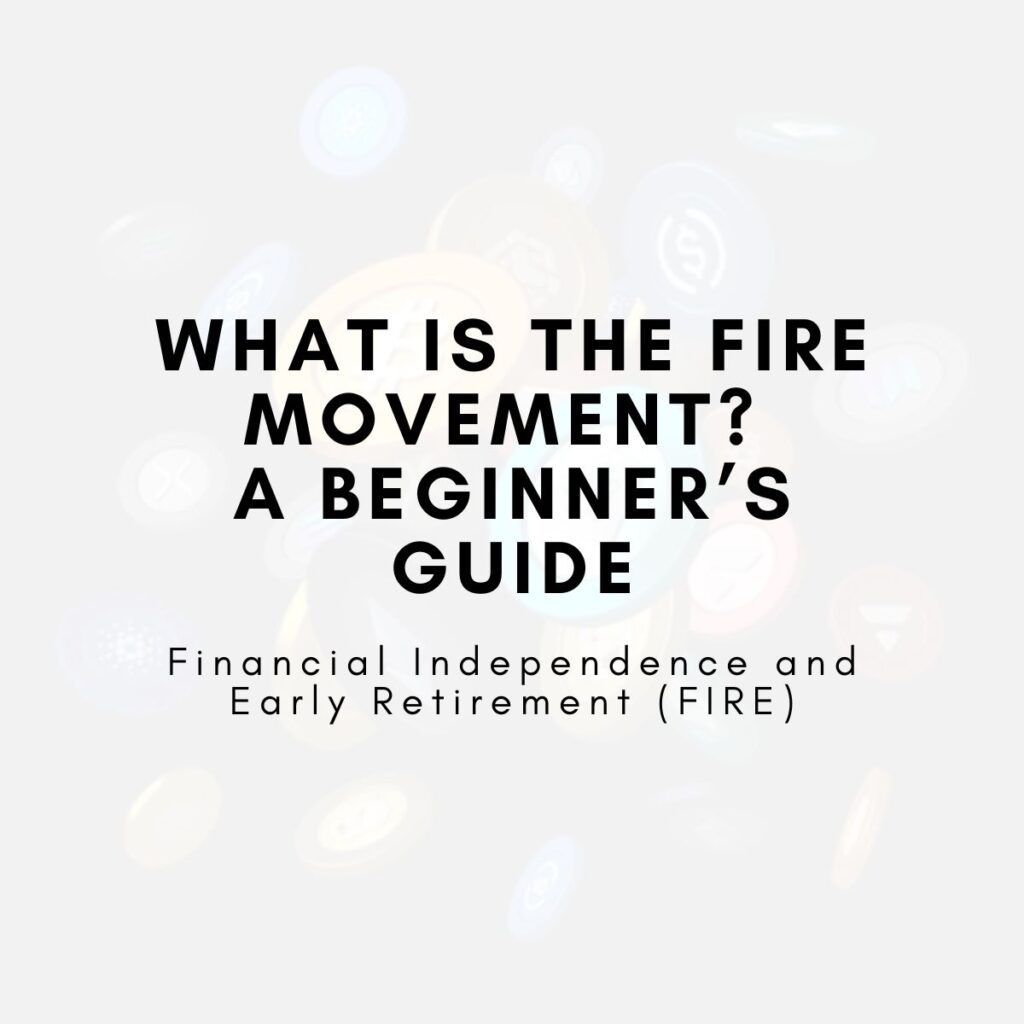
What is the FIRE (Financial Independence, Retire Early)?
The FIRE (Financial Independence, Retire Early) movement is a lifestyle and financial strategy focused on achieving financial independence and retiring far earlier than the traditional retirement age. By saving aggressively and investing wisely, FIRE followers aim to accumulate enough wealth to live off passive income and gain the freedom to choose how they spend their time. This beginner’s guide will explain the core principles of the FIRE movement, explore different types of FIRE, and provide practical steps to help you begin your journey toward financial independence and early retirement.
Table: Summary of the FIRE Movement – Key Concepts and Steps to Achieve Financial Independence
| Section | Summary | Key Tips | Examples |
|---|---|---|---|
| What is the FIRE Movement? | The FIRE movement focuses on achieving financial independence by saving and investing aggressively to retire early. It allows individuals to regain control over their time. | Start by understanding the basics of FIRE: save aggressively, live frugally, and invest wisely. The goal is financial independence at a younger age. | Chris and Sarah achieved financial independence by saving 70% of their income, retiring early with a modest lifestyle. |
| Types of FIRE | FIRE has different approaches, including Lean FIRE, Fat FIRE, and Barista FIRE, each catering to different lifestyle choices and savings goals. | Choose the FIRE type that best suits your desired retirement lifestyle. Lean FIRE is frugal, while Fat FIRE allows for more comfort in retirement. | Michelle chose Fat FIRE, aiming for a luxurious lifestyle in retirement with an $80,000 annual spending goal, while Jake pursued Barista FIRE. |
| How to Achieve FIRE | Achieving FIRE involves assessing your current financial situation, saving a high percentage of your income, and investing wisely for long-term growth. | Review your budget, increase your savings rate, and choose investments like low-cost index funds or real estate to build wealth. | Rachel monitored her progress and made adjustments to her savings strategy when she found her original plan was not on track. |
| Challenges of the FIRE Movement | The FIRE movement requires high savings rates and can be difficult for those used to a higher standard of living. Additionally, future expenses, like healthcare, must be planned for. | Be aware of the challenges: adjusting your lifestyle and overestimating future expenses. Plan for changes in healthcare and inflation, and keep a realistic mindset. | James and Emily struggled with reducing their living expenses but managed by downsizing their home and cutting non-essential spending. |
| Conclusion | The FIRE movement offers a path to financial independence and early retirement but requires dedication and significant lifestyle changes. | Stay committed to aggressive savings, investing smartly, and re-evaluating your progress to stay on track for early retirement. | By saving and investing diligently, Rachel was able to retire in her 40s and pursue hobbies and travel without financial worries. |
This table summarizes the key sections of the FIRE movement, offering an overview of its core principles, various approaches to FIRE, actionable tips, and real-life examples of people who have successfully implemented these strategies. Whether you’re looking to retire early with a modest lifestyle (Lean FIRE) or aiming for a more comfortable retirement (Fat FIRE), this table breaks down the essential steps for achieving financial independence. Each example showcases the different ways individuals have approached their FIRE journey, providing inspiration and guidance for those looking to start their own path to financial freedom.
Introduction
The idea of retiring early has always been a dream for many, but it often seemed like an unattainable goal. Enter the FIRE (Financial Independence, Retire Early) movement, which has gained significant traction in recent years. The concept behind FIRE is simple: save and invest a large portion of your income in order to achieve financial independence and retire far earlier than the traditional age of 65.
FIRE is not about quitting work and lounging on a beach for the rest of your life. Instead, it’s about gaining the financial freedom to pursue the things that truly matter to you, whether that means working part-time, traveling the world, or focusing on personal projects. The movement encourages frugality, smart investing, and strategic financial planning to build a life where money no longer controls your time.
In this guide, we will break down the FIRE movement, its core principles, different strategies for achieving financial independence, and provide practical steps to get started. Whether you’re just beginning to think about your financial future or looking for ways to retire earlier, this guide will give you all the insights you need to begin your journey toward FIRE.
What is FIRE? Understanding the Basics
Defining Financial Independence
At its core, FIRE is about achieving financial independence (FI). Financial independence means having enough wealth and passive income that you no longer need to work to cover your basic living expenses. For FIRE followers, this usually means accumulating enough savings to support 25 times your annual expenses, based on the idea of the 4% rule. The 4% rule suggests that you can safely withdraw 4% of your investments each year without depleting your principal, allowing you to live off the returns.
The goal of FIRE is to reach this point as early as possible—often in your 30s or 40s—so that you can retire long before the traditional retirement age.
The FIRE Movement’s Founding Principles
The FIRE movement is built on several core principles:
- Frugality: FIRE followers typically adopt a lifestyle of extreme frugality, cutting out unnecessary expenses and saving a high percentage of their income. This allows them to accumulate wealth faster.
- Aggressive Saving and Investing: FIRE advocates recommend saving anywhere from 50% to 70% of your income, which is significantly higher than the average American savings rate. This requires making significant lifestyle adjustments, such as reducing housing costs, driving older cars, or embracing minimalism.
- Smart Investing: Building wealth through investments is a crucial part of the FIRE strategy. FIRE followers invest in low-cost index funds, real estate, or other passive income streams to grow their wealth while they continue to work toward financial independence.
- Time Freedom Over Traditional Retirement: FIRE is about reclaiming your time, rather than simply stopping work altogether. It offers the freedom to choose how and when you work, or to step away entirely if desired.
Types of FIRE
Lean FIRE
Lean FIRE is the strategy where you achieve financial independence with a more modest lifestyle. You aim to live frugally during retirement, keeping expenses to a minimum. This is typically the most extreme version of FIRE, as it requires spending well below the average standard of living. People who pursue Lean FIRE might live in smaller homes, forego luxuries, and adopt a minimalist lifestyle.
Example: Chris and Sarah, a couple in their mid-30s, live on $30,000 per year. They have saved aggressively over the years and, through investing, have accumulated enough to withdraw 4% annually. While their retirement lifestyle is modest, they are financially independent and able to pursue passions and travel without worrying about money.
Fat FIRE
On the other end of the spectrum is Fat FIRE, which is for those who want to retire with a more comfortable or luxurious lifestyle. While the savings rate required for Fat FIRE is significantly higher, it allows for more flexibility and a higher standard of living during retirement.
Example: Michelle, a 40-year-old tech entrepreneur, saved aggressively for 15 years. Now, she has accumulated enough to retire at 45 and travel the world in comfort. Unlike Lean FIRE, she plans to spend $80,000 per year in retirement, enjoying a much higher lifestyle.
Barista FIRE
Barista FIRE is a middle ground between traditional work and full FIRE. This strategy involves accumulating enough savings to cover most of your expenses but continuing to work part-time or at a low-stress job, often for health benefits or personal fulfillment. It’s perfect for those who don’t want to quit working completely but want the freedom to pursue passions without being tied to a traditional 9-to-5 job.
Example: Jake, a 33-year-old graphic designer, has saved enough to cover most of his expenses but works part-time at a coffee shop to enjoy social interaction and health insurance benefits. He’s able to travel frequently, pursue hobbies, and have more free time.
How to Achieve FIRE: Steps to Get Started?
1. Assess Your Current Financial Situation
The first step to achieving FIRE is understanding where you stand financially. Start by tracking your income, expenses, and debts. This will help you identify areas where you can cut back and boost your savings rate.
Actionable Step: Use budgeting apps or spreadsheets to categorize your monthly expenses. Focus on eliminating non-essential spending and paying off high-interest debt, such as credit card balances.
2. Increase Your Savings Rate
The key to FIRE is saving as much as possible. FIRE followers typically save 50-70% of their income, which means living well below their means. Consider increasing your savings rate by reducing expenses like eating out, cable subscriptions, and shopping for non-essential items.
Real-Life Example: James and Emily, a couple with a combined income of $120,000, decided to increase their savings rate to 60% by cutting back on their housing costs. They downsized to a smaller home and reduced travel spending, putting the extra money into investment accounts.
3. Invest Wisely
Investing is crucial to achieving FIRE, as it allows your wealth to grow passively over time. The most popular investment strategy among FIRE followers is to invest in low-cost index funds, which track the stock market’s performance. Other options include real estate investments or dividend-paying stocks.
Actionable Step: Consider opening an IRA or contributing to your 401(k) to take advantage of tax benefits. Diversify your portfolio to balance risk and ensure long-term growth.
4. Monitor Your Progress and Adjust as Needed
Once you start on the path to FIRE, it’s important to periodically review your progress. Revisit your budget, track investment performance, and make adjustments to stay on course.
Example: Rachel set a goal to retire in 10 years but realized that her savings were growing slower than expected. She increased her contributions to her 401(k) and switched to higher-yielding investments. Monitoring progress allowed her to adjust her plan to stay on track.
Challenges of the FIRE Movement
High Initial Savings Rate
One of the biggest challenges of FIRE is achieving such a high savings rate, which often requires significant lifestyle changes. Cutting expenses can be difficult, especially if you are used to a certain standard of living.
The Risk of Overestimating Future Expenses
While the 4% rule is a widely accepted guideline, it’s based on historical market returns and doesn’t guarantee future success. FIRE followers need to carefully plan for potential changes in expenses, such as healthcare, inflation, and unexpected life events.
Dealing with Social and Psychological Factors
Another challenge of FIRE is the mental aspect. It’s difficult to avoid social pressures that encourage spending. Many people feel a sense of accomplishment from material possessions or social status, and FIRE requires a mindset shift towards valuing time freedom over accumulating wealth.
Conclusion
The FIRE movement offers an exciting path toward financial independence and early retirement, but it requires dedication, planning, and a willingness to make significant changes in how you manage your finances. By saving aggressively, investing wisely, and living frugally, you can achieve financial freedom long before the traditional retirement age.
While it may not be easy, the sense of freedom and control over your time is a powerful motivator for those who choose this path. Whether you aim for Lean FIRE, Fat FIRE, or Barista FIRE, the journey toward financial independence is within reach for anyone committed to the cause.
Key Takeaways
- FIRE is about achieving financial independence and retiring early by saving and investing aggressively.
- There are different types of FIRE, such as Lean FIRE, Fat FIRE, and Barista FIRE, each with varying levels of lifestyle and savings needs.
- Key steps to achieving FIRE include assessing your financial situation, increasing your savings rate, and making wise investment decisions.
- FIRE requires significant lifestyle changes, including frugality and a shift in mindset towards valuing time over material possessions.
- While challenges exist, the benefits of financial freedom and time independence can make FIRE an appealing goal for those willing to put in the work.

